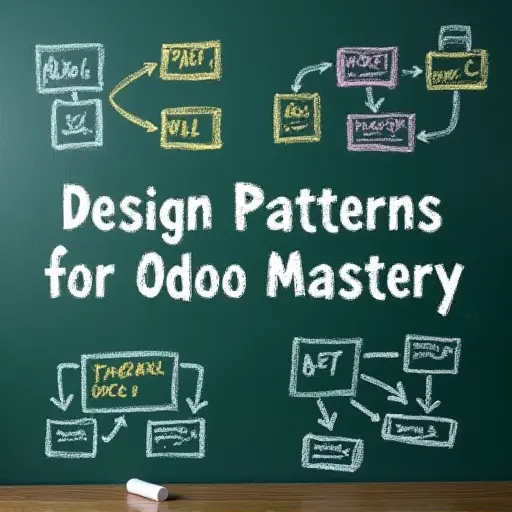Design Patterns for Odoo Mastery
FREE with Mastering Odoo Development Mastermind
Elevate your coding skills, future-proof your applications, and solve the most challenging development problems.
EARLY ACCESS PRICING - SAVE FOR A LIMITED TIME!
The Ultimate Course for Odoo Developers and Enterprise Architects
Take your Odoo development skills to the next level with the only course that teaches Design Pattern Mastery with direct applications in Odoo enterprise systems. This course is designed for developers, architects, and teams who want to build scalable, maintainable, and efficient Odoo applications using industry-standard design patterns.
Unlike other design pattern courses, this one is laser-focused on Odoo. Every pattern is demonstrated with real-world Odoo applications, modular business logic, and enterprise-grade solutions that you can apply immediately to your projects. If you want to go beyond coding and truly master the architecture of Odoo, this course is for you.
Why This Course is Essential for Odoo Developers
Odoo is powerful, but without structured software design, it can become difficult to scale and maintain. This course ensures that you can design robust, future-proof Odoo applications using proven design patterns.
Each lesson includes:
✅ Odoo-specific design pattern implementations used in real-world enterprise applications.
✅ Enterprise-grade software architecture principles applied directly to Odoo.
✅ Scalable, maintainable solutions that go beyond quick fixes and hacks.
✅ Clear, structured examples that will improve the way you design and build Odoo modules.
By the end, you’ll:
- Master 12+ essential design patterns tailored for Odoo development.
- Develop a deep understanding of modular, scalable Odoo architecture.
- Apply real-world business concepts that make your Odoo applications more flexible and powerful.
- Stand out as an expert Odoo developer capable of designing high-quality, extensible enterprise solutions.
Course Structure
Each section of this course focuses on a specific category of design patterns, ensuring deep understanding through multiple Odoo-specific examples and business-driven applications.
What Makes This Course Unique?
🔹 Multiple real-world Odoo applications per pattern—no generic examples, everything is relevant to Odoo development. 🔹 Focused on Enterprise Development—Learn how to scale Odoo beyond small modules and simple customizations. 🔹 Odoo-First Approach—We don't just teach patterns; we show you exactly how to implement them in Odoo. 🔹 Includes examples from popular games to make learning fun and reinforce complex concepts effortlessly.
What’s Inside the Course?
Introduction to Design Patterns in Odoo
- Introduction to Design Pattern Mastery
- Why Design Patterns Matter in Odoo Development
- Essential Concepts for Understanding Odoo Enterprise Architecture
Mastering Odoo & Software Design Patterns
- The Gang of Four: The Architects of Modern Software Design
- How Mastering Patterns Makes You a Better Odoo Developer
- Introduction to SOLID: Writing Maintainable and Scalable Odoo Code
- Understanding Design Patterns with UML Diagrams
- Applying Odoo Design Patterns in Real-World Business Applications
Creational Patterns
- Factory Pattern – Managing dynamic object creation in Odoo.
- Singleton Pattern – Ensuring global control over shared Odoo resources.
- Builder Pattern – Constructing complex objects efficiently within Odoo modules.
Structural Patterns
- Adapter Pattern – Bridging incompatible interfaces in Odoo integrations.
- Composite Pattern – Managing hierarchical business data structures in Odoo.
- Decorator Pattern – Extending object functionality dynamically in modular Odoo apps.
Behavioral Patterns – Mastering Dynamic Odoo Workflows
Business processes, automation, and interactions in Odoo require flexibility and efficiency. Behavioral patterns optimize these workflows to make your applications more powerful and modular.
In this section, you will learn:
- How to implement flexible business logic and automation in Odoo.
- How to apply behavioral patterns to real-world Odoo workflows and enterprise use cases.
- How to build scalable, event-driven Odoo applications.
🔹 Upgrade your Odoo architecture—Join Now!
- Strategy Pattern – Dynamically select business rules in Odoo workflows.
- Observer Pattern – Implement real-time notifications and event-driven models in Odoo.
- Command Pattern – Encapsulate user actions for logging, queuing, and auditing in Odoo.
- State Pattern – Model Odoo business process workflows dynamically based on user interactions.
- Mediator Pattern – Simplify complex Odoo system interactions with centralized controllers.
- Template Method Pattern – Create standardized, reusable Odoo automation frameworks.
Who Should Take This Course?
This course is for:
- Odoo Developers looking to build scalable, maintainable applications.
- Software Engineers eager to master industry-proven design strategies.
- Architects designing large-scale Odoo-based business solutions.
- Development Teams working on complex Odoo projects that require structured software design.
Fun examples and design challenges from popular games 🎲
To make learning even more engaging, this course features examples and design challenges from popular games like Monopoly, Risk, and SimCity. These real-world analogies help reinforce design patterns and make complex concepts easier to internalize—so you not only learn faster but retain the knowledge longer!
Get Started Today!
This course is designed for anyone with Odoo development experience, particularly those who want to go beyond simple module creation and truly master Odoo architecture.
🔹 Start designing better Odoo applications today—Enroll Now!
